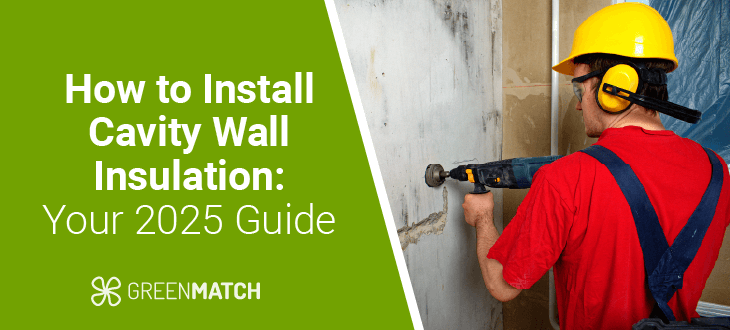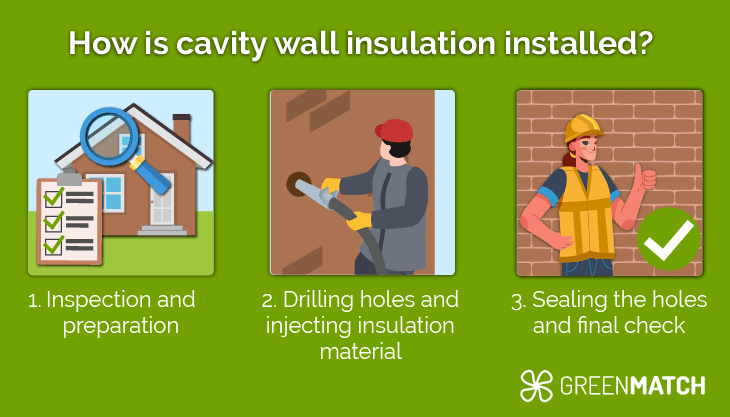Answer these simple questions and we will find you the BEST prices
Which type of solar quotes do you need?
It only takes 30 seconds
100% free with no obligation

Get Free quotes from insulation specialists near you

Save money by comparing quotes and choosing the most competitive offer

The service is 100% free and with no obligation
- GreenMatch
- Insulation
- Wall Insulation
- Cavity Wall Insulation
- Install Cavity Wall Insulation
How to Install Cavity Wall Insulation: Your 2025 Guide


- Most houses in the UK are constructed with either solid walls or cavity walls.
- Cavity walls consist of two layers with a gap or cavity between them. If your home was constructed after the 1920s, it will likely have a cavity wall.
- Approximately one-third of the heat lost in an uninsulated residence dissipates through the walls. Properly insulating cavity walls can conserve energy and reduce heating expenses.
Cavity wall insulation isn't just a home upgrade; it's an essential step toward improving energy efficiency and reducing heating bills. By sealing the gaps in your property's walls, you can greatly minimise heat loss and create a more comfortable living space. However, the installation process demands meticulous planning and execution to provide effectiveness and safety.
Are you thinking about insulating your home? Let GreenMatch handle all the research and vetting for you. Instead of spending countless hours searching through websites and scheduling appointments with installers, simply fill out our quick online form in 30 seconds, and we'll promptly send you up to 3 free quotes from professional installers in your local area. Click the button below to take the first step.
- Describe your needs
- Get free quotes
- Choose the best offer
It only takes 30 seconds



How is cavity wall insulation installed?

When insulating cavity walls, the installer will drill small 22mm holes at approximately 1m intervals in the exterior wall. Following this, specialised equipment will blow insulation into the cavity.
Cavity walls can be insulated by injecting insulation material into the walls from the outside. Insulation is injected, and then the holes are sealed. The process is typically done with mineral wool, polystyrene beads, or polyurethane foam. Professional installers complete the job in about two hours for an average house, leaving the house in its original condition.
To insulate cavity walls effectively, it is important to hire the services of a certified installer rather than attempting it as a DIY project.
1. Inspection and preparation
Before proceeding with cavity wall insulation, it's important to have a professional installer survey your home to determine the best insulation method. Depending on the characteristics of your house, such as narrow or uneven cavities, exposure to elements, or risk of flooding, different insulation materials may be recommended.
An option to consider for narrow or uneven cavities is filling the cavity with polyurethane foam, which is more expensive but highly effective and offers significant benefits. However, it's essential to have a specialist foam insulation installer survey your home to carry out this work. They'll provide recommendations on how to tackle existing damp problems (if any) to avoid your cavity wall insulation cause damp in the future
In the case of external walls shared with a neighbour, a cavity barrier is necessary to contain the insulation. For those living in a flat, obtaining consent from all residents in the building is required to insulate the entire building.
2. Drilling holes and injecting insulation material
Insulating cavity walls is commonly done by drilling a series of small holes, each approximately 25mm wide, into the wall at regular intervals and injecting insulation material into the cavity. After the insulation is blown in, the holes are refilled. In some cases, a telescopic lance system is used for hard-to-reach walls. For new-build properties, rigid insulation boards are often installed into the wall cavities as part of the construction process.
Mineral fibre is a material of loose fibres injected into the cavity space through specialist equipment. Polystyrene beads, like all cavity insulation, are injected into the cavity space using specialist equipment. Spray foam insulation is a foam-based substance injected into cavity walls, where it expands to create an airtight insulation seal.
4. Sealing the holes and final check
Following the installation of cavity wall insulation, it is essential to seal the injection holes to maintain the wall's structural integrity and maximise the insulation's effectiveness. These holes should be carefully filled with mortar or a suitable material to prevent air leaks and moisture from penetrating the wall.
A final inspection is necessary to confirm that all cavities are adequately filled without gaps or voids. This inspection ensures the insulation performs optimally, improving energy efficiency and overall comfort.
Is your property suitable for cavity wall insulation installation?

Determine if your property is suitable for cavity wall insulation by considering the following factors:
Identifying cavity walls
Houses that were constructed after the 1920s often show specific brickwork patterns. When you see a consistent stretcher bond pattern in the brickwork, this usually indicates that the house has cavity walls. On the other hand, if you observe a mix of stretchers and headers in the brickwork, it usually suggests that the house has solid walls.
Brickwork condition
The brickwork should be carefully inspected to ensure it is in good condition, without any cracks or gaps. The brickwork must be well-maintained to provide adequate insulation and prevent potential moisture seepage issues.
Cavity width
The cavity, which refers to the space between walls or within a building structure, should have a minimum width of 35mm to accommodate most types of insulation. However, certain insulation materials may necessitate a wider minimum width of 50mm to ensure effective installation and performance.
Professional assessment
A professional installer can assess these factors, confirm your property's suitability for cavity wall insulation, and suggest necessary alternatives. For more information on other options, check our article on cavity wall insulation alternatives.
Assuring your property meets these criteria will help you decide about installing cavity wall insulation.
Can you install cavity wall insulation yourself?
Attempting DIY cavity wall insulation is not recommended because the installation process is complex and requires specialised equipment, skills, and knowledge of specific techniques. Professional installers have the expertise and experience to provide correct and safe installation, and they often have warranties and guarantees for their work, giving homeowners peace of mind.
Improper do-it-yourself (DIY) insulation installation can lead to many problems, such as uneven coverage and gaps, which can significantly decrease its effectiveness. This can result in issues like moisture retention, mould growth, and potential damage to the structure. Inadequate sealing during DIY installation can also lead to air leaks and moisture infiltration, ultimately impacting the insulation's performance.
Selecting a professional installer is optimal for ensuring a high-quality, efficient, and long-lasting cavity wall insulation installation. Their expertise, specialised equipment, and adherence to best practices in insulation installation can guarantee a successful outcome. Furthermore, the warranties and guarantees they offer provide homeowners with invaluable peace of mind, assuring them of protection in the event of any installation issues.
How much does it cost to install cavity wall insulation?
Installing cavity wall insulation typically costs between £1,000 and £4,600. For example, the price of insulating a 3-bedroom semi-detached home costs around £2,700.
Several factors can impact the total cost of cavity wall insulation, such as the property's size, the type of insulation material, and the complexity of the installation.
While a DIY approach may appear cost-effective, it often involves renting specialised equipment, which can significantly raise the overall cost.
Learn more about insulation prices, check our dedicated page on cavity wall insulation costs.
Find cavity wall insulation installers near you
When installing cavity wall insulation, it is imperative to engage government-approved installers. These professionals possess the necessary certifications to adhere to quality and safety standards, guaranteeing that the insulation meets regulatory requirements. It's also important to be aware that if you plan to apply to the Great British Insulation Scheme (GBIS) or the Energy Company Obligation (ECO4) Scheme, it is mandatory to hire a certified installer; the grants don't fund DIY projects.
Requesting quotations from multiple installers is the best approach. This practice facilitates comparing pricing, services, and customer feedback. Investing time in collecting and comparing quotes is a smart move. It allows you to ensure the best value and excellent installation for your home. Start your search for approved cavity wall insulation installers today to make an informed decision and get the best possible service for your insulation needs.
Are you thinking about insulating your home? Let GreenMatch handle all the research and vetting for you. Rather than spending countless hours searching through websites and scheduling appointments with installers, fill out our quick online form in just 30 seconds, and we'll send you up to 3 free quotes from professional installers in your local area. Click the button below to get started!
- Describe your needs
- Get free quotes
- Choose the best offer
It only takes 30 seconds



FAQ
A professional installer instals cavity wall insulation and drills small 22mm holes at approximately 1m intervals in the exterior wall. Then, specialised equipment blows insulation into the cavity. Cavity walls can be insulated by injecting insulation material from the outside. Holes are drilled in the walls, insulation is injected, and then the holes are sealed. The process is usually done with mineral wool, polystyrene beads, or polyurethane foam. Professional installers complete the job in about two hours for an average house, leaving your home in its original condition.
It is not recommended to attempt do-it-yourself cavity wall insulation due to the complex nature of the installation process. Successful installation requires specialised equipment, skills, and knowledge of specific techniques. Professional installers have the expertise and experience to ensure correct and safe installation. They often provide warranties and guarantees for their work, providing homeowners with peace of mind regarding the quality and safety of the insulation.
Professionals drill small, evenly spaced holes in the property’s external walls. These holes are typically about 22mm in diameter and are placed in a pattern to secure an even distribution of the insulation material throughout the cavity.
The cost of cavity wall insulation is between £1,000 and £4,600. For instance, insulating a standard three-bedroom semi-detached home usually costs around £2,700, giving you a clear idea of what to expect.
Several factors can impact the total cost of cavity wall insulation, such as the property’s size, the type of insulation material, and the complexity of the installation. While a DIY approach may appear cost-effective, it often involves renting specialised equipment, which can significantly raise the overall cost.
Improper installation of cavity wall insulation can lead to several issues, including moisture problems, reduced thermal insulation effectiveness, air leakage, and potential structural problems. These issues may cause dampness, mould growth, higher energy bills, and compromised structural integrity. Hiring experienced professionals for the installation can reduce these risks and maximise the benefits of insulation.

Akif is a copywriter at GreenMatch since 2023. With a keen interest in community sustainability, green solutions and the role of digital media in identifying climate trends, he aims to hone in on his background in International Studies and Digital Media to provide a multidisciplinary approach to written content rooted in credible research and accuracy.
We strive to connect our customers with the right product and supplier. Would you like to be part of GreenMatch?

- How to Install Cavity Wall Insulation: Your 2025 Guide
- How is cavity wall insulation installed?
- Is your property suitable for cavity wall insulation installation?
- Can you install cavity wall insulation yourself?
- How much does it cost to install cavity wall insulation?
- Find cavity wall insulation installers near you
- FAQ
